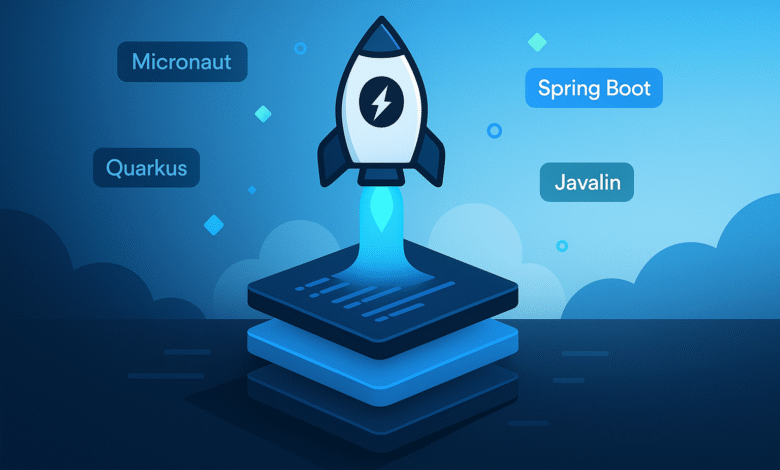
If you’re building web applications or microservices in Java, you’ve probably noticed how overwhelming the choices can be. The Java ecosystem is huge, and picking the right tool matters for your project’s success. But here’s the thing: you don’t need a massive, heavy framework every time. Sometimes a lightweight, focused Java microframework is exactly what you need to get the job done faster.
Best Java microframeworks have become increasingly popular because they let developers move quickly without carrying unnecessary baggage. Unlike full-stack frameworks that throw everything at you, microframeworks for Java keep things simple and nimble. They handle the core tasks like routing, request handling, and response management, then get out of your way. You get to choose your own libraries and tools based on what your application actually needs.
In this guide, we’ll walk through seven excellent Java microframework options that developers are choosing in 2025, from established favorites to newer cloud-native powerhouses. Whether you’re building REST APIs, microservices, or lean web apps, you’ll find a solid option here.
What Makes a Good Java Microframework
Before we dive into specific frameworks, let’s talk about what separates a good lightweight Java framework from the rest. Speed matters because your application needs to start quickly, especially in containerized and serverless environments. Memory efficiency is crucial since you’re often running multiple services. Developer experience counts too because you want to enjoy coding, not fight your tools. Good documentation and community support make learning and troubleshooting way easier.
The best Java microframeworks also embrace modern development practices. They work well with cloud platforms like Kubernetes. Many use ahead-of-time compilation through GraalVM to create optimized native binaries. They’re designed from the ground up for microservices architecture, not retrofitted to support it.
1. Spring Boot: The Industry Standard
Spring Boot deserves its place here because it revolutionized how developers build Java web applications. It’s still the most popular choice for building microservices and cloud-native applications. Spring Boot eliminates the boilerplate configuration that makes traditional Java development tedious. Instead of writing endless XML files, you get sensible defaults that work right away.
What makes Spring Boot special for Java microservices is its entire ecosystem. Spring Cloud provides tools for service discovery, configuration management, and distributed tracing. If you need to build a complete microservices system, Spring Boot plus Spring Cloud gives you everything out of the box.
Key strengths:
- Massive community and countless learning resources available online
- Seamless integration with cloud platforms like AWS and Azure
- Extensive library of official and third-party extensions
- Excellent documentation and industry adoption in enterprises
Spring Boot does start heavier than some alternatives, but it’s gotten much better. If you’re working in a team or on a large-scale application, this is likely your safest bet.
2. Quarkus: Built for Cloud and Containers
Quarkus might be the future of Java microservices. Backed by Red Hat, Quarkus is specifically designed for Kubernetes and containerized environments. Where it really shines is startup time and memory consumption. Quarkus applications can start in under a second with minimal memory footprint, which is game-changing for serverless deployments.
Quarkus achieves this through compile-time optimization and GraalVM native compilation. Your code gets analyzed and optimized before it runs, not while it’s running. This means super-fast startup and consistently good performance.
Why developers love Quarkus:
- Lightning-fast startup times (often under 100ms)
- Incredibly low memory usage compared to traditional Java
- Native compilation produces truly standalone executables
- Excellent for serverless, cloud, and Kubernetes environments
- Reactive and imperative programming both supported
If you’re building cloud-native applications and want to squeeze every bit of efficiency from your infrastructure, Quarkus is worth serious consideration.
Also Read: How to Choose the Right JavaScript Framework in 2025
3. Micronaut: Lightweight and Powerful
Micronaut sits in the sweet spot between simplicity and functionality. It’s built from the ground up for modern, fast application development without the bloat of larger frameworks. Like Quarkus, Micronaut uses compile-time code generation, which means faster startup and less memory usage at runtime.
What’s really clever about Micronaut is how it handles dependency injection. Instead of scanning your code at runtime, Micronaut figures out dependencies at compile time. This contributes to its lean runtime footprint. You get the convenience of dependency injection without the startup cost.
Micronaut’s standout features:
- Supports Java, Groovy, and Kotlin for flexibility
- Compile-time dependency injection reduces overhead
- Built-in support for cloud platforms and service discovery
- Great for building REST APIs and microservices
- Reactive streams built in for non-blocking I/O
Micronaut is gaining real traction among developers who want modern lightweight Java frameworks without the complexity of Spring. The learning curve is reasonable, and the framework stays out of your way.
4. Javalin: Keep It Simple
Sometimes you just want to build something straightforward without mysterious magic happening behind the scenes. That’s where Javalin comes in. It’s an openly unopinionated Java microframework that gives you explicit control over everything.
Javalin runs on top of Jetty, one of the most reliable and respected web servers in the Java world. The framework itself is just a few thousand lines of code, making it easy to understand and debug. You write simple, clear code without worrying about hidden dependencies or automatic configuration.
What Javalin brings to the table:
- Extremely simple and straightforward API
- Works identically in Java and Kotlin
- No hidden magic or automatic configuration
- Great for REST APIs and small to medium applications
- Perfect for developers who value explicitness over convention
If you’re tired of frameworks doing too much behind the scenes and you want complete visibility into how your application works, Javalin is fantastic. It’s especially popular with developers who appreciate clean, readable code.
5. Helidon: Oracle’s Answer
Helidon is Oracle’s entry into the modern Java microservices space. Don’t let its relative newness fool you; it’s a solid, well-designed framework from a company with decades of enterprise Java experience. Helidon combines fast startup times, low memory usage, and simple API development in one package.
Helidon uses compile-time code generation just like Quarkus and Micronaut. It’s also particularly well-suited to running on Kubernetes and in containerized environments. If you’re running Java microservices on Kubernetes with custom or Oracle infrastructure, Helidon deserves consideration.
Helidon’s strengths:
- Fast startup and low memory footprint from day one
- Excellent performance characteristics for cloud-native work
- Strong backing from Oracle
- Simple, intuitive API design
- Good support for service discovery and monitoring
Helidon is gaining adoption among organizations already invested in the Oracle ecosystem, but it’s good enough that you don’t need Oracle products elsewhere to use it effectively.
6. Dropwizard: Mature and Stable
Dropwizard has been around for years and has proven itself in production systems worldwide. It’s a perfect choice if you value stability and don’t need cutting-edge compile-time optimization tricks. Dropwizard bundles together battle-tested libraries like Jetty, Jackson, and Jersey into a cohesive package.
What’s great about Dropwizard is that it handles operational concerns that developers often overlook. It gives you built-in support for configuration, application monitoring, logging, and metrics. This means your application ships with the infrastructure code for real production use.
Why teams choose Dropwizard:
- Proven, stable framework with long track record
- Built-in support for metrics, monitoring, and configuration
- Combines excellent libraries you know and trust
- Perfect for RESTful web services and APIs
- Straightforward and predictable behavior
Dropwizard might not have the blazing startup times of newer frameworks, but it’s reliable and gets the job done. Teams that value proven stability over the newest technology often stick with Dropwizard.
7. Vert.x: Reactive Powerhouse
Vert.x takes a different approach than most frameworks on this list. It’s built from the ground up for reactive, non-blocking, event-driven programming. If you need to handle massive numbers of concurrent connections efficiently, Vert.x is your answer.
Vert.x powers high-performance applications that need to handle real-time communication, WebSockets, and reactive streams. It’s not a traditional framework with conventions and structure; it’s more of a powerful toolkit for building reactive systems. This makes it best for developers comfortable with reactive programming patterns.
Vert.x’s advantages:
- Exceptional performance with high concurrency
- Reactive and event-driven architecture built in
- Works great for real-time applications
- Polyglot support means you can use multiple languages
- Excellent for applications needing WebSocket support
Vert.x has a steeper learning curve because reactive programming requires a different mindset than traditional imperative programming. But if you’re building systems that truly need to handle massive scale and real-time interactions, it’s worth learning.
Comparing Performance and Use Cases
Different projects have different needs, so here’s how to think about choosing between these best Java microframeworks.
For traditional enterprise applications and established teams, Spring Boot remains the safest choice. You’ll find more developers who know it, more stack overflow answers, and more community resources.
For cloud-native and Kubernetes deployments where startup time and memory matter, Quarkus and Micronaut are your speed leaders. Pick Quarkus if you want the most actively developed option with the biggest backing. Pick Micronaut if you want a slightly smaller, more community-driven project.
If you value simplicity and explicitness, Javalin is hard to beat. You’ll understand exactly what your code is doing with no surprises.
For rock-solid stability in production systems, Dropwizard continues to deliver. It won’t dazzle you with cutting-edge features, but it won’t let you down either.
For reactive, real-time applications, Vert.x is the clear choice. Accept the learning curve and you’ll build incredibly efficient systems.
Helidon works well if you’re in the Oracle ecosystem or just want another solid compile-time optimized option.
Getting Started with Your First Microframework
Pick one framework and actually build something with it. Download the starter project, follow the documentation, and create a simple API. You’ll learn more from an hour of hands-on coding than from reading ten articles.
Start small. You don’t need to build your entire system at once. Create a basic REST endpoint, experiment with routing and request handling, then gradually add more features as you become comfortable.
Most of these Java microframeworks have excellent official tutorials to get you running quickly. Take advantage of them. Pay attention to how the framework guides you toward best practices.
Don’t overthink the choice. Each of these frameworks is genuinely good. Pick one that sounds interesting and dive in. You can always try another framework on your next project.
Resources for Learning More
For a deeper dive into microservices architecture and modern Java development practices, check out InfoWorld’s complete guide to Java microframeworks, which covers many of these frameworks in detail. Additionally, Mkyong’s top Java frameworks article provides updated information on how different frameworks fit into the 2025 landscape.
Conclusion
The best Java microframeworks for modern developers depend on what you’re building and your team’s priorities. Spring Boot remains the industry standard for good reason, offering a complete ecosystem that works for nearly every scenario.
For cloud-native development, Quarkus and Micronaut lead with remarkable performance characteristics that make them ideal for containerized and serverless deployments. Javalin appeals to developers who prefer simplicity and explicit control over their codebase. Helidon provides a solid option with Oracle backing, Dropwizard offers proven stability for production systems, and Vert.x delivers exceptional performance for reactive, high-concurrency applications.
The Java ecosystem gives you genuine choices, so pick a lightweight Java framework that aligns with your project requirements, your team’s expertise, and your deployment environment. Start building today, and you’ll quickly discover which Java microframework feels right for your work.











